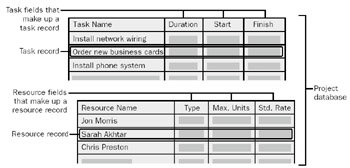Chapter 4: Viewing Project Information
Overview
To plan, track, and manage your project with Microsoft Office Project 2003, you enter a variety of detailed information regarding tasks , resources, assignments, durations, resource rates, and more. Project 2003, in turn , calculates certain entries to create even more information, including start dates, finish dates, costs, and remaining work. In Microsoft Project, more than 400 distinct pieces of information, including your own custom information, are available for tasks, resources, and assignments. The more tasks, resources, and assignments you have in your project, and the more custom capabilities you use, the more these pieces of information are multiplied.
There's no way you could look at this mass of project information at one time and work with it in any kind of meaningful or efficient way. To solve this problem, Microsoft Project organizes and stores the information in a database . All information associated with an individual task, for example, is a single record in that database. Each piece of information in that record is a separate field (see Figure 4-1).

Figure 4-1: Each task represents a single record in your project database, with all associated information represented by individual fields.
| Note | The project database is distinct from the SQL Server database that Microsoft Project uses to store data. In the SQL Server database, information about one task can actually be spread across multiple tables in multiple records. |
When you need to look at or work with a particular set of information, you choose a particular view to be displayed in the Microsoft Project workspace. A view filters the project information in a specific way according to the purpose of the view and then presents that layout of information in the Microsoft Project workspace so you can easily work with it. More than 25 views are built into Microsoft Project.
You can rearrange the project information presented in a view. You can sort information in many views by name , date, and so on. You can group information, for example, by complete versus incomplete tasks. You can filter information to see only the information you want, for example, only tasks that are assigned to a particular resource. These concepts and techniques are all presented in this chapter.
EAN: 2147483647
Pages: 268
- Structures, Processes and Relational Mechanisms for IT Governance
- An Emerging Strategy for E-Business IT Governance
- Linking the IT Balanced Scorecard to the Business Objectives at a Major Canadian Financial Group
- The Evolution of IT Governance at NB Power
- Governance Structures for IT in the Health Care Industry